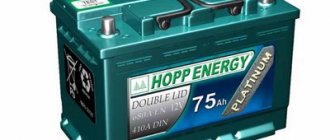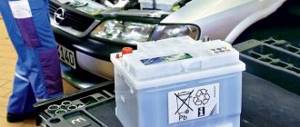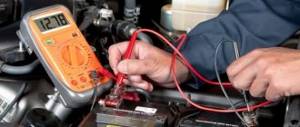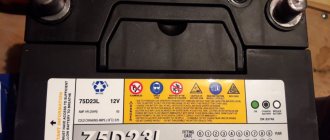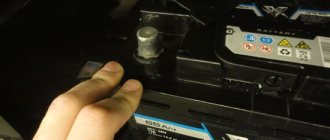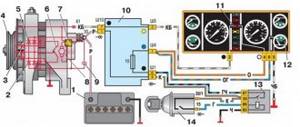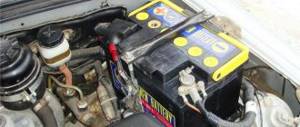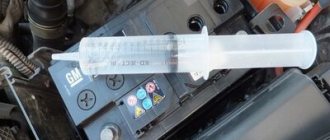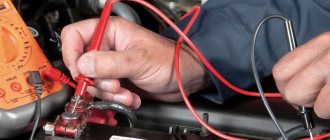Removing the battery in cold weather
In winter, the battery charges less well, which prevents you from starting the engine right away. The decision depends on the condition of your battery: a relatively new one usually does not fail in the cold - just turn on the high beams for a few minutes to “warm up”, and then start the engine. It is advisable to take the older one into a warm place and charge it there, which will allow you to drive in winter without problems.
To remove the battery you do not need to have any special skills - the sequence is simple:
- Open the hood of the car;
- We remove the “insulation” (it is not present in all cars);
- First of all, disconnect the “negative” terminal;
- Then you need to remove the “positive” terminal;
- Remove the battery mount;
- We remove the battery.
Attention! It is necessary to remove the terminals in this order - an error can lead to a short circuit, which can break the entire electronic equipment of the machine.
After removal, it is recommended to check the battery for clogging of the ventilation holes by unscrewing the plugs; wipe it. Never turn the battery over or knock it!
All car owners are well aware that in winter the car battery goes through difficult trials. What does it cost him to start a cold engine just once, when he clearly does not have enough strength to carry out such a procedure? After all, as a rule, the battery does not have time to recharge during short winter runs.
That is why in winter you should try to help him, so that his work can provide you with a comfortable and quiet ride, so that you do not have to dance from the cold, looking for someone who will agree to give your car a “light.”
If you are not going to park your car in winter, then you need to prepare its battery for winter operation before the cold weather sets in. You should not think that if the car operates confidently and without problems in the summer, everything will be fine with it even in winter frosts. Many car owners remember about their battery only with the onset of the first serious cold weather. It is then that they begin to get fed up with unsuccessful and frequent attempts to start the car engine. And often in this case, the appearance of high current discharges with a duration of more than 20 seconds is observed, causing the plates to melt. When preparing a battery for use in winter cold, first of all, you need to clean its ventilation holes, housing and cover from dirt , and then wipe the battery surface with a rag pre-moistened with ammonia. Then, using warm water, remove deposits from the terminals and terminals of the poles, and using grain sandpaper, remove the oxide film. After installing the battery in place, you need to firmly tighten the bolts, and also lubricate the terminals and terminals with lithol on the outside.
Diagnostics and selection of shock absorbers for the car
If small cracks or chips are found on the battery case or plastic cover, they should be removed using a soldering iron. To eliminate more serious damage, it is best to seek help from specialists.
The next stage of preparing the battery for winter includes checking the condition level, as well as charging its individual cells. When performing this, you will need some special equipment, especially a load fork. It would be a good idea to have all of the following battery procedures performed by professionals.
Specialists will check not only the electrical parameters of the battery, but will also bring them back to normal if your battery is still suitable for further use. It would be good to inspect the electrical equipment of your car. Remember that when driving with a broken relay, any (even expensive) battery can become unusable for further use in a few days, so you should not skimp on such an examination. After carefully preparing the battery for use in winter, you must try to constantly keep it in “good shape”.
The use of low-viscosity motor oils makes it easier to start the battery in winter. It turns out that when, when starting the engine in winter, it starts to work faster, then less load falls on the battery.
It should be remembered that in winter cold the electrochemical processes in the battery slow down, and its capacity decreases and becomes slightly less than the nominal one. If you need to go on an important trip, it is best to place the battery in a warm place for at least 2 hours. If you store your car in an unheated garage or parking lot, it is best to wrap your battery overnight so that the electrolyte in it cools more slowly than the air around it. Before starting the engine, it is advisable to “wake up” the battery by flashing the high beams.
Premature failure of spark plugs
If you use your car little in the winter , then it is still advisable to recharge its battery almost once a month during this period of time. It is good to monitor the density of the battery electrolyte every week, maintaining its value within the range of 1.27 g/m3. cm up to 1.28 g/cc. see. If necessary, you can add distilled water to the battery before the trip, which will help prevent the electrolyte from freezing. Some experts believe that in winter it is necessary to increase the density of the electrolyte in the battery to almost 1.30 g/cubic meter. cm. In their opinion, this will help make the battery work more reliably in cold weather, but at the same time reduce its service life.
And one more piece of advice that can be considered unworthy. It is advisable not to use your battery as a “lighter” for another car, since the extreme loads that fall on it are unlikely to do it any good.
Storing the battery indoors in winter
For long-term storage, it is recommended to disconnect one of the terminals. This will lead to the battery being discharged and occasionally it will need to be connected to power. In severe frosts, it is enough to store the battery in the basement or cellar - this will protect it from freezing.
Sometimes the battery needs to be recharged
Please note that the methods for storing an “empty” battery and a full one are different: the room for the first must have air circulation and low humidity.
When storing the battery, prevent sunlight from entering the battery housing. Direct exposure to rays deforms the plastic and leads to failures in subsequent operation. Before storage, carefully check the tightness of the plugs - make sure they are tight. The case must not be damaged - otherwise the battery needs service.
What should you have in your car in winter?
Now let's look at how to properly store a battery in Russian winter conditions. Some domestic car enthusiasts (and there are many of them) prefer not to use their car in winter. This is mainly afforded by those who have the opportunity to keep a car not in the open air, but at least in an unheated garage.
If you are one of this group of car owners, then the minimum that needs to be done to preserve the battery is to disconnect one of the battery terminals. And ideally, completely remove the battery and take it home, where it will winter well in a warm room. This applies when the garage is not heated. If the car will spend the winter in a warm room, then such measures should not be taken.
How to use a battery in winter
Sub-zero temperatures greatly affect battery performance. In extreme cold, the electrolyte thickens, which complicates the chemical processes of the battery itself. This leads to a decrease in current production and affects the engine starting in cold weather. For low temperatures, there are electric batteries with a large capacity, for example, 10 ampere-hours.
There are special insulation for batteries
In off-road conditions, the battery is subject to constant shaking. Electrolyte begins to leak out of the plates, increasing the chance of a short circuit. For such needs, there are special batteries that have plates of the same polarity rolled into a separator.
Frequent use of the starter greatly discharges the battery, creating the risk of being left without energy at the most inopportune moment. The problem can be partially solved by replacing the battery with an analogue one that has a self-charging function and is equipped with a plastic separator envelope.
Calcium batteries withstand temperature changes better
The calcium batteries described above can withstand both low and high temperatures, can be stored for many months without use, and are installed as easily as regular ones, without requiring recharging. But most drivers will still continue to use the usual alkaline batteries. There are two rules for their operation:
- Monitor the battery charge level;
- Check the electrolyte level - it should cover all cells. Always carry distilled water with you, because the electrolyte tends to evaporate both in summer and winter.
Electrolyte density
The density of the electrolyte is based on the ratio of distilled water and sulfuric acid - 1 part to 1.25 parts, respectively. Thus, the optimal density starts from a coefficient of 1.25, but the higher it is, the more frost-resistant the electrolyte.
To measure the density in a battery, you need a device called a hydrometer.
Attention! Work with electrolyte must be carried out using rubber gloves, avoiding contact with skin and clothing. Smoking is strictly prohibited!
Insert the tip of the hydrometer into the open mouth of the jar. Using a bulb, draw a small amount of electrolyte so that the float of the device floats in the body without touching the walls, top and bottom. Wait until the liquid calms down, then take readings by eye. If the difference in density is 0.01 g/cubic cm, then add distilled water or put the battery on equalizing charging. When the density coefficient decreases to 1.24 or below, the battery needs to be charged.
The best temperature for testing is +15 ... +25 degrees Celsius. At other temperatures, correction of the results is required. After use, the hydrometer must be washed with water.
Adding distilled water is the simplest measure to control the electrolyte level. Systematically check the density in the battery, because water tends to boil away, reducing the volume of electrolyte (in some cases to a critical level). Do not take the battery to extremes. You can extend the battery life with your own hands.
Preparation
- Stock up on containers for draining used electrolyte and diluting new one;
- Before work, check the plastic for resistance to electrolyte.
To increase the electrolyte density you need:
- container with measuring marks;
- hydrometer;
- soldering iron;
- electrolyte;
- enema pear;
- battery water;
- drill;
- distilled water.
We measure the density in each jar. If it is 1.25–1.28, and the spread is no more than 0.01, then the battery is normal and can be used. If the readings fluctuate at 1.18–1.20, then you need to add an electrolyte with a density of 1.27.
- Using an enema, pump out the largest possible volume of old electrolyte from the jar and measure it;
- Fill in a new solution at the rate of half of the pumped out;
- Gently rock the battery to mix the liquids;
- Measure the density - if the value is insufficient, you need to add more electrolyte;
- Fill the remainder with distilled water.
Critically low level
If the reading is below 1.18, battery acid is needed, since adding electrolyte will not solve this problem. The process is similar to the above. You may not achieve the required density the first time and will have to repeat the procedure.
If the reading is less than 1.18, the entire electrolyte must be replaced. Use a blower to pump out all the solution, then close the ventilation holes. With the battery on its side, drill 3-3.5mm holes in the bottom of each can. Before the new hole, drain the remaining electrolyte from the past.
Rinse the battery thoroughly with distilled water. Solder the holes using acid-resistant plastic. Fill with new fluid. It is recommended to prepare the new electrolyte yourself, making it a little denser than recommended for your climate. Please note that even a complete fluid change does not guarantee a service life comparable to a new battery. To extend the battery life, do not forget to charge and check the density in a timely manner.
Storing the battery in winter
But let’s imagine that we still removed the battery from the car. Each type of battery has its own special conditions for storing it in winter. For example, for dry-charged batteries, the main thing is to store them in a warm and ventilated room - then no problems with storage and subsequent operation will arise.
The only caution is to avoid direct exposure of the battery to sunlight. The flooded battery must only be stored in an upright position. After the battery has been removed from the car, it must be cleaned of dirt and electrolyte residues. Carefully inspect the battery and if you find insufficient electrolyte level, add distilled water to those jars where it is necessary. After restoring the electrolyte level, you need to recharge the battery with a special charger.
How to properly store a car
If it is not possible to check the battery charge level before the onset of stable heat, you can use the following simple method of storing the battery in winter. After the charging procedure is completed (exactly how to recharge is described a little higher), drain the electrolyte from the battery.
We rinse the jars with distilled water, and this must be done at least twice, and the second time the water should stand in the jars for about 15 minutes. Now pour the boric acid solution into the empty battery. After this, wipe the battery with a dry cloth and put it away until the warm season. This method guarantees the safety of the battery and eliminates the possibility of spontaneous discharge.
Before installing the battery on the car after winter hibernation, it is necessary to drain the boric acid and fill in the electrolyte solution. After the electrolyte has settled (this process takes an average of 45 minutes), we measure its density. And only after that we install the battery on the car.
